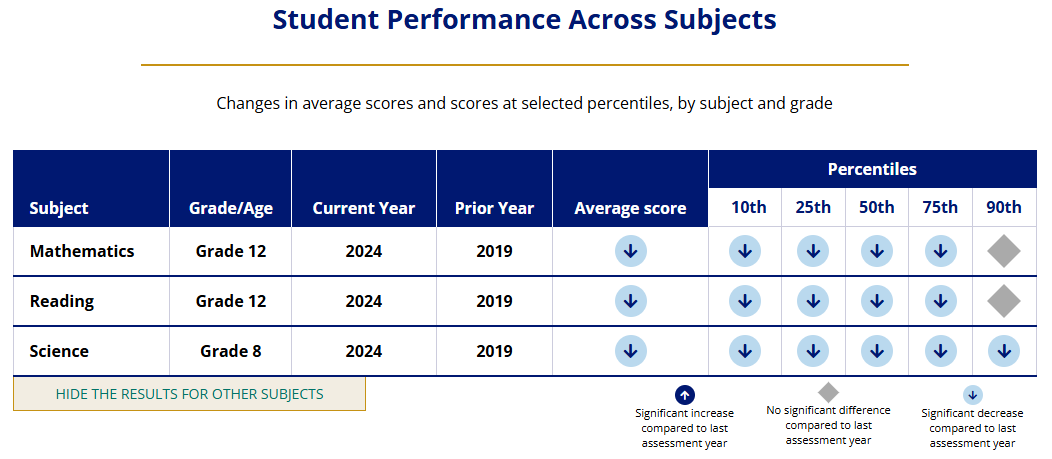I was chatting with the head of a private school last fall when she made an interesting observation. Like many private schools, her school experienced a flood of parents in the wake of Covid who saw what their children were taught during the online public school classroom experience and wanted to give them a far better education.
However, this headmistress reported such alarm and concern were not as present in newer parents. In fact, those with children born during Covid seemed oblivious to the many education problems unmasked during the pandemic and were happily trotting their children toward their first years in the same old forms of substandard education.
But recent data shows that concerns about American education are still very justified. Nowhere is this clearer than the recent data release from The Nation’s Report Card showing declines in 12th-grade math and reading since the last time the test ran right before the pandemic. Today only 35% of 12th-graders are proficient in reading. Unless things drastically improve in the next few years, it seems fair to say that 2 in every 3 students entering kindergarten this year will exit the education system unable to read proficiently.

Every school out there – public, private, or otherwise – promotes itself as the best at promoting learning and ensuring student success. But the numbers say otherwise.
What are parents to do? How can they know the elements of a good education so they can either provide it for their children themselves, or recognize it in quality institutions?
Author Dorothy Sayers recognized this problem way back in 1947 and laid out some core elements of quality education in her essay “The Lost Tools of Learning.” For younger students, Sayers offers the following three general categories:
1) Latin Instruction
Sayers recommended this dead language not to advance a hoity-toity, stuck-up attitude in students, but because Latin is foundational to so many other areas of education. “Latin cuts down the labor and pains of learning almost any other subject by at least 50 percent,” she writes, going on to note its importance in many foreign languages, science, literature, and history.
2) Memorization and Recitation
Although a technique often scorned by modern methods, Sayers encourages an education that teaches children to commit facts, dates, and figures to heart during their early years, chanting them out loud in order to better ingrain them in memory. Such should be done in history, geography, science, math, and English – with poetry and classical stories taking prominence in the latter.
3) Theology
“Theology is the Mistress-science,” Sayers writes, and without it, a student’s education is “full of loose ends.”
What kind of theology should schools teach? Sayers recommends basic components such as “the story of God and Man in outline—i.e., the Old and New Testament presented as parts of a single narrative of Creation, Rebellion, and Redemption—and also with ‘the Creed, the Lord’s Prayer, and the Ten Commandments.’”
For those in the middle school years, Sayers advances Logic as one of the most important elements of learning.
“Logic is the art of arguing correctly,” Sayers explains. She admits that an argumentative nature in a child is the last thing many of us want to deal with, but as it is a reality, it is better to channel argumentation for good purpose, rather than letting it run wild. Thus, a good middle school education will teach students to properly debate, to ask questions, and to spot the logical fallacies regularly used in media and daily life.
If a student has such grounding in his early years, then he will undoubtedly be off and running in his high school years – sure to be one of the growing few in the category of those 12th-graders who can read proficiently.
Sayers concludes:
We have lost the tools of learning—the axe and the wedge, the hammer and the saw, the chisel and the plane—that were so adaptable to all tasks. Instead of them, we have merely a set of complicated jigs, each of which will do but one task and no more, and in using which eye and hand receive no training, so that no man ever sees the work as a whole or ‘looks to the end of the work.’
Sadly, our education system will likely continue to crumble. Only the parents who take heed to these “lost tools of learning” and seek to instill them in their children, both at home and in school, will be able to adequately prepare their children for leadership and success in adulthood.
—
The republication of this article is made possible by The Fred & Rheta Skelton Center for Cultural Renewal.
Image Credit: Pexels
30 comments















30 Comments
Mae L. Lamere
September 10, 2025, 5:53 pmI’ve profited $17,000 in just four weeks by working from home comfortably part-time. I was devastated when I lost my previous business right away, but happily, I found this project, which has allowed me to get thousands of dollars from the comfort cfs06 of my home. Each person may definitely complete this simple task and earn extra money online by
visiting the next article———>>> https://www.jobs99.site
REPLYCarrie Kilman@Mae L. Lamere
September 11, 2025, 4:59 amHello, my name is Carrie Kilman from Birmingham, UK. Last month, my fiancé broke up with me, leaving me devastated. I spent weeks agonizing, crying, and feeling guilty, sinking into the lowest point of my life. I was so overwhelmed by stress and depression that I feared for my health. Desperate for a solution, I searched online and discovered a powerful spell caster named Dr. Peter, known for solving relationship problems. After reaching out to him and explaining my situation, he assured me that my fiancé would return within 24 hours. To my amazement, my fiancé called, apologized, and wanted us to be together again. Thanks to Dr. Peter, we're now happily reunited. If you need help, contact Dr. Peter at [email protected] or WhatsApp +2348162247974
You can also visit his websites:
REPLYJimbeau@Carrie Kilman
September 11, 2025, 5:00 amI get paid over 220 Dollars per hour working from home with 2 kids at home. i never thought i’d be able to do it but my best friend earns over 15k a month doing this and she convinced me to try. it was all true and has totally changed my life. This is what I do, check it out by Visiting Following Website…
REPLY.
.
HERE—————⊃⫸ https://Www.Cash43.Com
RSLewis@Jimbeau
September 11, 2025, 5:00 amGoogle is now paying $300 to $500 per hour for doing work online work from home. Last paycheck of me said that $20537 from this easy and simple job. Its amazing and earns are awesome. No boss, full time freedom and earnings are in front of you. This job is just awesome. Every person can makes income online with google easily….
REPLY.
More Details For Us→→ http://Www.Payathome9.Com
Charlotte Kay@RSLewis
September 12, 2025, 1:49 amI get paid over $220 per hour working from home with 2 kids at home. i never thought i’d be able to do it but my best friend earns over 15k a month doing this and she convinced me to try. the potential with this is endless…,
COPY HERE➤➤ https://Www.EarnApp1.Com
REPLYYolonda Bass@Charlotte Kay
September 12, 2025, 1:51 amStart making cash right now… Get more time with your family by doing jobs that only require for you to have a computer and an internet access and you can have that at your home. Start bringing up to $2700-$5700+Dollar per week . I've started this job and I've never been happier and now I am sharing it with you, so you can try it too. You can check it out here…
Here is I started_______ https://Www.HighProfit1.Com
REPLYTamika Mcmillan@Carrie Kilman
September 12, 2025, 6:12 amGoogle easily work and google pays me every hour and every week just $5K to $8K for doing online work from home. I am a universty student and I work n my part time just 2 to 3 hours a day easily from home. Now every one can earn extra cash for doing online home system and make a good life by just open this website and follow instructions
on this page… https://work99.site
REPLYjuliya@Mae L. Lamere
September 12, 2025, 12:42 pmCash earning job to earns more than $700 per day. getting paid weekly more than $3500 or more simply doing easy work online. no special skills required for this job and regular earning from this are just awesome. all you need is 2 hrs a day for this job and earning are awesome. every person can get this by follow details here…
COPY THIS→→→→ http://Www.Cashprofit7.site
REPLYJuliya@Mae L. Lamere
September 12, 2025, 12:45 pmCash earning job to earns more than $700 per day. getting paid weekly more than $3500 or more simply doing easy work online. no special skills required for this job and regular earning from this are just awesome. all you need is 2 hrs a day for this job and earning are awesome. every person can get this by follow details here…
COPY THIS→→→→ http://Www.Cashprofit7.site
REPLYgroger@Mae L. Lamere
September 15, 2025, 7:08 amGoogle pay 500$ per hour my last pay check was $19840 working 10 hours a week online. My younger brother friend has been averaging 22k for months now and he works about 24 hours a week.
REPLYJust Open This Website…….. http://www.get.money63.com
groger@Mae L. Lamere
September 16, 2025, 7:05 amJOIN US Everybody can earn 250$/h + daily 1K !!! Start now making every month extra $6000-$22000 or more by just doing an easy online work from home. Last month i have earned and received $19650 from this work by giving this only 3 hrs a a day.Every person can now get this work and start earning online by.
REPLYFor details check ——-⫸ http://www.get.money63.com
groger@Mae L. Lamere
September 17, 2025, 6:25 amI have made 96,760 Buck just last month by working online from my home. I am a full time college student and just doing this in my free time for few hours per week by using my laptop.Everyone can check this out and start making cash online in a very easy way by just following instructions……
This Website….HERE══════►►► http://www.get.money63.com
REPLYCarrie Kilman
September 11, 2025, 4:58 amHello, my name is Carrie Kilman from Birmingham, UK. Last month, my fiancé broke up with me, leaving me devastated. I spent weeks agonizing, crying, and feeling guilty, sinking into the lowest point of my life. I was so overwhelmed by stress and depression that I feared for my health. Desperate for a solution, I searched online and discovered a powerful spell caster named Dr. Peter, known for solving relationship problems. After reaching out to him and explaining my situation, he assured me that my fiancé would return within 24 hours. To my amazement, my fiancé called, apologized, and wanted us to be together again. Thanks to Dr. Peter, we're now happily reunited. If you need help, contact Dr. Peter at [email protected] or WhatsApp +2348162247974
You can also visit his websites:
REPLYPatricia Lovick
September 11, 2025, 11:47 amHow To Recover Your Bitcoin Without Falling Victim To Scams: A Testimony Experience With Capital Crypto Recover Services, Contact Telegram: @Capitalcryptorecover
Dear Everyone,
I would like to take a moment to share my positive experience with Capital Crypto Recover Services. Initially, I was unsure if it would be possible to recover my stolen bitcoins. However, with their expertise and professionalism, I was able to fully recover my funds. Unfortunately, many individuals fall victim to scams in the cryptocurrency space, especially those involving fraudulent investment platforms. However, I advise caution, as not all recovery services are legitimate. I personally lost $273,000 worth of Bitcoin from my Binance account due to a deceptive platform. If you have suffered a similar loss, you may be considering crypto recovery, The Capital Crypto Recover is the most knowledgeable and effective Capital Crypto Recovery Services assisted me in recovering my stolen funds within 24 hours, after getting access to my wallet. Their service was not only prompt but also highly professional and effective, and many recovery services may not be trustworthy. Therefore, I highly recommend Capital Crypto Recover to you. i do always research and see reviews about their service, For assistance finding your misplaced cryptocurrency, get in touch with them, They do their jobs quickly and excellently, Stay safe and vigilant in the crypto world. Contact: [email protected] You can reach them via email at [email protected] OR Call/Text Number +1 (336)390-6684 his contact website: https://recovercapital.wixsite.com/capital-crypto-rec-1
REPLYPatricia Lovick
September 11, 2025, 11:48 amHow To Recover Your Bitcoin Without Falling Victim To Scams: A Testimony Experience With Capital Crypto Recover Services, Contact Telegram: @Capitalcryptorecover
Dear Everyone,
I would like to take a moment to share my positive experience with Capital Crypto Recover Services. Initially, I was unsure if it would be possible to recover my stolen bitcoins. However, with their expertise and professionalism, I was able to fully recover my funds. Unfortunately, many individuals fall victim to scams in the cryptocurrency space, especially those involving fraudulent investment platforms. However, I advise caution, as not all recovery services are legitimate. I personally lost $273,000 worth of Bitcoin from my Binance account due to a deceptive platform. If you have suffered a similar loss, you may be considering crypto recovery, The Capital Crypto Recover is the most knowledgeable and effective Capital Crypto Recovery Services assisted me in recovering my stolen funds within 24 hours, after getting access to my wallet. Their service was not only prompt but also highly professional and effective, and many recovery services may not be trustworthy. Therefore, I highly recommend Capital Crypto Recover to you. i do always research and see reviews about their service, For assistance finding your misplaced cryptocurrency, get in touch with them, They do their jobs quickly and excellently, Stay safe and vigilant in the crypto world. Contact: [email protected] You can reach them via email at [email protected] OR Call/Text Number +1 (336)390-6684 his contact website: https://recovercapital.wixsite.com/capital-crypto-rec-1
REPLYPatricia Lovick
September 11, 2025, 11:50 amHow To Recover Your Bitcoin Without Falling Victim To Scams: A Testimony Experience With Capital Crypto Recover Services, Contact Telegram: @Capitalcryptorecover
Dear Everyone,
I would like to take a moment to share my positive experience with Capital Crypto Recover Services. Initially, I was unsure if it would be possible to recover my stolen bitcoins. However, with their expertise and professionalism, I was able to fully recover my funds. Unfortunately, many individuals fall victim to scams in the cryptocurrency space, especially those involving fraudulent investment platforms. However, I advise caution, as not all recovery services are legitimate. I personally lost $273,000 worth of Bitcoin from my Binance account due to a deceptive platform. If you have suffered a similar loss, you may be considering crypto recovery, The Capital Crypto Recover is the most knowledgeable and effective Capital Crypto Recovery Services assisted me in recovering my stolen funds within 24 hours, after getting access to my wallet. Their service was not only prompt but also highly professional and effective, and many recovery services may not be trustworthy. Therefore, I highly recommend Capital Crypto Recover to you. i do always research and see reviews about their service, For assistance finding your misplaced cryptocurrency, get in touch with them, They do their jobs quickly and excellently, Stay safe and vigilant in the crypto world. Contact: [email protected] You can reach them via email at [email protected] OR Call/Text Number +1 (336)390-6684 his contact website: https://recovercapital.wixsite.com/capital-crypto-rec-1
REPLY